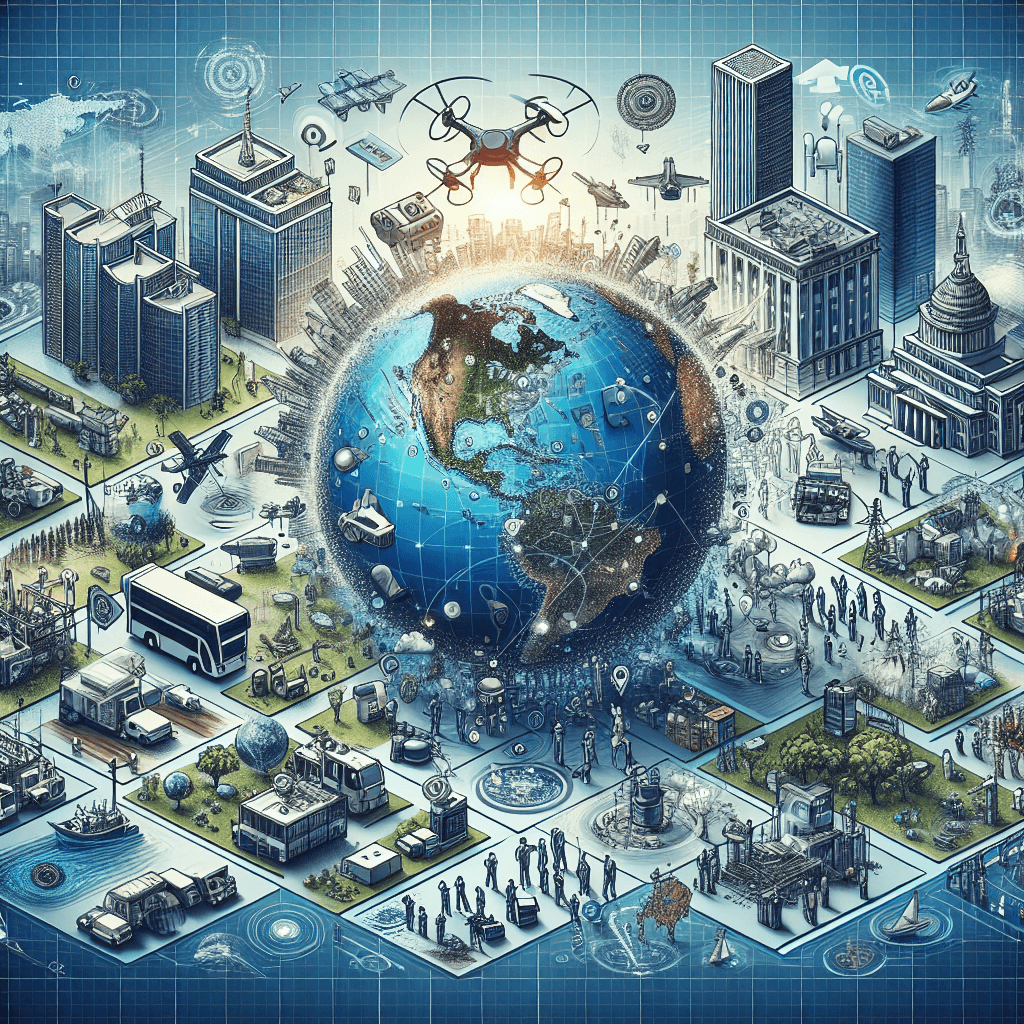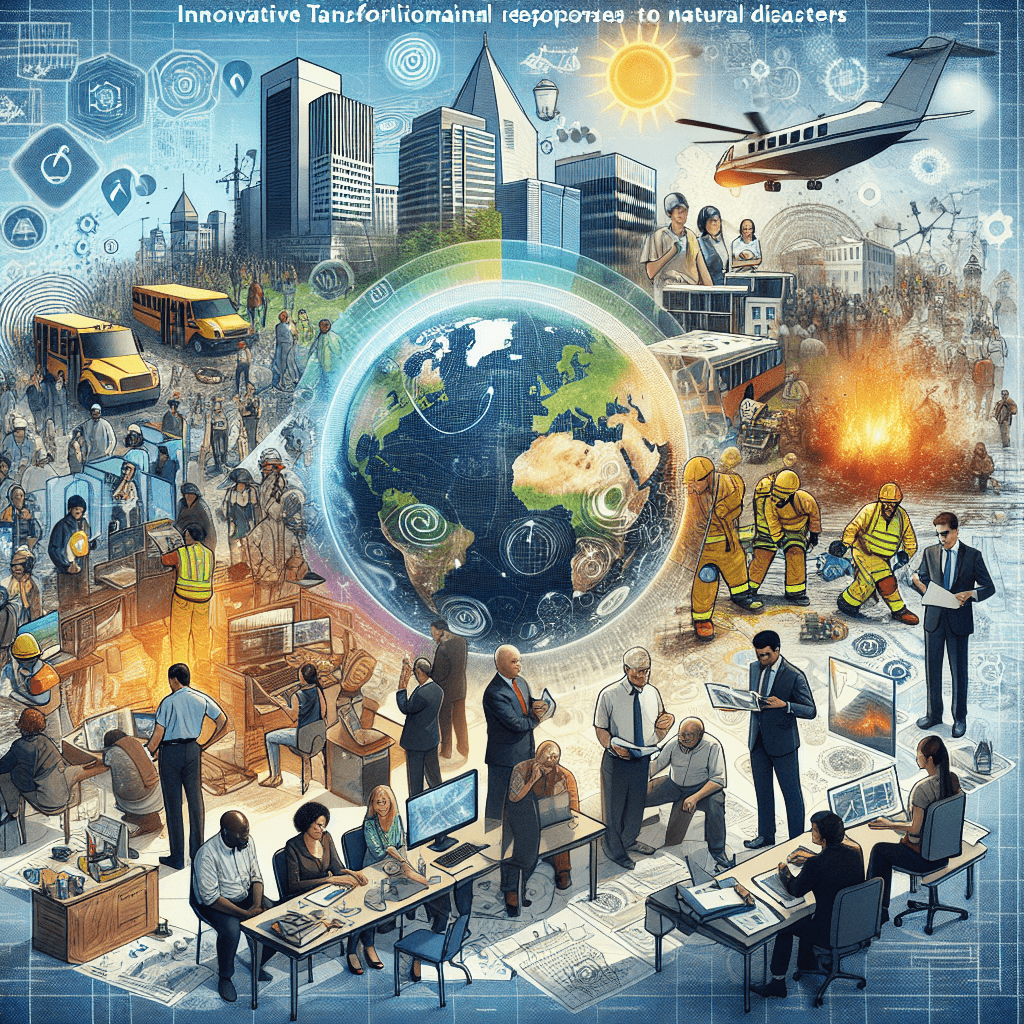In the face of increasing frequency and severity of natural disasters, governments around the world are adopting innovative approaches to revolutionize their responses. Previously, these efforts mainly focused on providing immediate relief and aid to affected communities. However, recognizing the need for more proactive and comprehensive strategies, governments are now investing in advanced technologies, data-driven decision-making, and collaborative partnerships. By embracing a forward-thinking approach, governments are not only enhancing their ability to respond effectively to natural disasters but also minimizing the devastating impacts on human lives and infrastructure.

Table of Contents
Adopting Advanced Technology
In recent years, governments across the globe have been increasingly adopting advanced technology to enhance their responses to natural disasters. One notable area where advanced technology is being utilized is the use of drones for damage assessment. Drones equipped with high-resolution cameras and sensors can be deployed to assess the extent of damage caused by natural disasters quickly and accurately. These drones can capture images and collect data from areas that are difficult for humans to access, providing valuable information for response and recovery efforts.
Another key technological advancement is the utilization of artificial intelligence (AI) in predicting disasters. AI algorithms can analyze vast amounts of data, including weather patterns, historical records, and geographical data, to identify potential disaster risks and predict their occurrence. By leveraging AI, governments can better understand the likelihood and severity of disasters, enabling them to take proactive measures and allocate resources more effectively.
Furthermore, the concept of the Internet of Things (IoT) has revolutionized early warning systems. IoT devices, such as sensors and monitors, can be deployed in vulnerable areas to collect real-time data on various environmental factors. This data can be analyzed to detect early warning signs of disasters, such as changes in temperature, humidity, or air quality. By incorporating IoT technology into early warning systems, governments can provide timely alerts to communities, allowing them to evacuate or take appropriate actions to mitigate the impact of disasters.
Developing Effective Warning Systems
To protect communities from the devastating effects of natural disasters, governments are focused on developing effective warning systems. One crucial aspect of this is the implementation of early warning systems. These systems involve the integration of various technologies, such as seismic sensors, weather monitors, and satellite imagery, to detect and predict the occurrence of disasters. By providing timely and accurate warnings, governments can reduce the loss of life and property.
In addition to traditional warning systems, governments are utilizing social media and mobile apps for alerts. Social media platforms, like Twitter and Facebook, have become important channels for disseminating information during disasters. Governments are leveraging these platforms to provide real-time updates, evacuation instructions, and emergency contact details. Mobile apps, specifically designed for disaster alerts, have also gained popularity. These apps can send push notifications to users, providing them with essential information and instructions during emergencies.
Improving weather forecasting capacities is another vital component of developing effective warning systems. Governments are investing in advanced meteorological technologies, such as weather radars and satellite imagery, to accurately predict the path and intensity of severe weather events. By enhancing weather forecasting capabilities, governments can issue more accurate warnings and help communities prepare and respond to impending disasters.
Enhancing Emergency Communication
During natural disasters, effective and reliable communication is of utmost importance. Governments are taking steps to establish dedicated communication networks that can withstand the impact of disasters. By constructing robust communication infrastructure, governments can ensure that essential communication channels, such as emergency hotlines and radio frequencies, remain operational even in the face of severe disruptions.
Satellite and radio communications play a crucial role in emergency communication. Satellites can provide connectivity in remote or inaccessible areas, enabling governments to maintain communication links with affected communities. Radio communication, on the other hand, serves as a reliable fallback option when other forms of communication are unavailable or unreliable. Governments are investing in satellite and radio communication systems to establish resilient and redundant communication networks for disaster response.
In addition to traditional communication methods, governments are developing mobile communication apps specifically designed for use during emergencies. These apps can facilitate two-way communication between authorities and affected individuals, allowing for better coordination and information exchange. Mobile communication apps can provide updates, emergency contact information, and real-time alerts to users, helping them stay informed and connected during critical times.
Improving Disaster Response Coordination
Effective coordination among various agencies and stakeholders is vital for a successful disaster response. Governments are taking steps to enhance disaster response coordination by forming national task forces. These task forces bring together representatives from different government agencies, such as emergency management, health, transportation, and public safety, to coordinate response efforts. The task forces ensure collaboration and efficient utilization of available resources during emergencies.
Promoting interagency collaboration is another key aspect of improving disaster response coordination. Governments are encouraging different agencies to work together through joint training exercises, information sharing platforms, and regular meetings. By fostering collaboration, governments can ensure a unified and coordinated response to disasters, minimizing duplication of efforts and maximizing efficiency.
Regular emergency drills are also being conducted to improve disaster response coordination. These drills simulate various disaster scenarios and allow different agencies to practice their roles and responsibilities. Through these drills, governments can identify gaps in coordination, communication, and response capabilities, enabling them to make necessary improvements and refine their response plans.

Strengthening Infrastructure Resilience
To mitigate the impact of natural disasters, governments are focusing on strengthening infrastructure resilience. Implementing building codes and regulations is a crucial step in this process. Governments are enacting and enforcing building codes that require structures to be designed and constructed to withstand potential disasters, such as earthquakes, hurricanes, or floods. By ensuring that buildings meet specified safety standards, governments can minimize the risk of structural failure and enhance the resilience of critical infrastructure.
Investing in resilient infrastructure design is another important strategy. Governments are considering the long-term resilience of infrastructure projects, taking into account potential climate change impacts and natural hazards. By incorporating measures such as flood-proofing, elevation, and reinforcement, governments can make infrastructure more resistant to disasters. Additionally, incorporating green infrastructure solutions, such as sustainable drainage systems or rooftop gardens, can help absorb excess water, reduce stormwater runoff, and mitigate the impact of floods.
The use of innovative construction materials is also being explored to strengthen infrastructure resilience. Governments are incentivizing the use of materials that are more resistant to damage caused by disasters. For example, fiber-reinforced concrete or composites can provide increased resistance to fires or earthquakes. Innovations such as self-healing materials and smart sensors embedded in structures can also help detect and repair damage, increasing the overall resilience of infrastructure.
Supporting Local Communities
Governments recognize the critical role of local communities in disaster management and are taking steps to support and empower them. One approach is the creation of community-based disaster management committees. These committees consist of local residents, community leaders, and representatives from relevant government agencies. They serve as a platform for communities to actively participate in disaster preparedness and response activities. By involving local communities, governments can tap into their local knowledge, resources, and networks, strengthening overall disaster management efforts.
Empowering local volunteers and first responders is another key aspect of supporting local communities. Governments are providing training, resources, and equipment to individuals who volunteer to respond to disasters within their communities. By equipping these volunteers with necessary skills and tools, governments can enhance their capacity to provide immediate assistance during emergencies. First responders, such as firefighters, paramedics, and search and rescue teams, are also being provided with specialized training and equipment to effectively respond to different types of disasters.
In addition to physical support, governments are providing financial assistance and aid to communities affected by natural disasters. This includes funding for immediate relief operations, such as providing temporary shelters, food, and medical assistance. Governments are also implementing programs for long-term recovery and rebuilding, providing financial support and incentives for families and businesses to rebuild their lives and livelihoods.

Enhancing Public Awareness and Education
public awareness and education play a crucial role in building resilient communities. Governments are actively promoting disaster preparedness campaigns to educate the public about potential risks and the importance of preparedness. These campaigns include public service announcements, educational materials, and community events that raise awareness about specific hazards and recommended actions. By increasing public awareness of disasters and preparedness measures, governments can encourage individuals and communities to take proactive steps to protect themselves and their property.
Integrating disaster education in school curricula is another effective approach. Governments are working with educational institutions to incorporate disaster-related topics in the curriculum. This ensures that students receive essential knowledge and skills related to disaster preparedness, response, and recovery. By integrating disaster education into school curricula, governments can prepare the future generation to better understand and respond to natural disasters.
Organizing awareness workshops and training is yet another way governments are enhancing public awareness and education. These workshops provide individuals with practical skills and knowledge on disaster preparedness and response. Topics covered may include first aid, search and rescue techniques, evacuation procedures, and psychological support. By equipping individuals with the necessary information and skills, governments can empower them to become active participants in disaster management efforts.
Improving Data Collection and Analysis
Accurate and reliable data is essential for effective disaster management. Governments are working towards improving data collection and analysis by establishing centralized disaster databases. These databases consolidate information related to hazards, vulnerabilities, and past disaster events. By having comprehensive and up-to-date data, governments can make informed decisions in allocating resources, developing response plans, and implementing mitigation measures.
Implementing remote sensing and geographic information system (GIS) technologies is another significant step in improving data collection and analysis. Remote sensing involves the use of satellites or aerial imagery to collect data on various aspects of the environment, including land cover, vegetation, and topography. GIS technology enables the integration and analysis of spatial data, providing valuable insights into hazard exposure, vulnerability, and risk. By leveraging these technologies, governments can enhance their understanding of disaster-prone areas, assess the impact of disasters, and plan for effective response and recovery.
In addition, governments are utilizing big data and predictive analytics to improve disaster management capabilities. Big data refers to the vast amounts of information collected from multiple sources, including social media, sensors, and government databases. By analyzing big data, governments can identify patterns, trends, and anomalies that can help predict and mitigate the impact of natural disasters. Predictive analytics, on the other hand, involves using statistical models and algorithms to forecast the occurrence and severity of disasters based on historical data. By harnessing the power of big data and predictive analytics, governments can make data-driven decisions and improve their overall disaster management strategies.

Addressing Climate Change Adaptation
As the frequency and intensity of natural disasters increase due to climate change, governments are prioritizing climate change adaptation measures. One key aspect is the creation of climate change resilience plans. These plans outline strategies and actions to mitigate the impact of climate change on communities and infrastructure. Governments are assessing vulnerable areas, identifying adaptation options, and implementing measures such as floodplain zoning, coastal protection, and ecosystem restoration. By taking proactive steps to adapt to climate change, governments can reduce the risks and vulnerabilities associated with natural disasters.
Implementing sustainable development practices is another important strategy for addressing climate change adaptation. Governments are encouraging sustainable land and resource management, promoting energy efficiency, and supporting renewable energy initiatives. By integrating sustainable development practices into policies and regulations, governments can reduce greenhouse gas emissions, enhance natural resource conservation, and build resilience to climate change impacts.
Furthermore, governments are promoting green infrastructure solutions as part of climate change adaptation efforts. Green infrastructure refers to natural or nature-based features that provide multiple benefits, such as flood mitigation, water filtration, and habitat restoration. Governments are investing in projects that utilize green infrastructure, such as green roofs, rain gardens, and urban forests, to enhance the resilience of communities and infrastructure. Green infrastructure solutions not only mitigate the impact of disasters but also contribute to improving overall environmental quality and community well-being.
Ensuring Swift Disaster Recovery
The swift recovery following a natural disaster is crucial for affected communities to rebuild their lives. To facilitate this process, governments are providing rapid post-disaster financial assistance. This includes immediate funding for emergency relief operations, as well as financial support for individuals and businesses to recover and rebuild. By offering timely financial assistance, governments can help communities restore essential services, repair infrastructure, and jumpstart economic recovery.
Implementing reconstruction and rehabilitation programs is another essential aspect of ensuring swift disaster recovery. Governments are developing comprehensive plans for the reconstruction and rehabilitation of affected areas. These plans involve assessing damage, prioritizing recovery activities, and coordinating the efforts of various stakeholders. Governments provide technical and financial support to help communities rebuild homes, schools, hospitals, and other critical infrastructure. By implementing reconstruction and rehabilitation programs, governments help affected communities recover and regain their normality in the aftermath of disasters.
In addition to physical recovery, governments prioritize psychological and emotional support for disaster survivors. The impact of a natural disaster can be traumatic, both in the immediate aftermath and in the long term. Governments are implementing programs that provide counseling services, mental health support, and trauma-informed care to individuals and communities affected by disasters. By addressing the psychological and emotional needs of survivors, governments can facilitate a more holistic and sustainable recovery process.
In conclusion, governments are revolutionizing their responses to natural disasters by adopting advanced technologies, developing effective warning systems, enhancing emergency communication, improving disaster response coordination, strengthening infrastructure resilience, supporting local communities, enhancing public awareness and education, improving data collection and analysis, addressing climate change adaptation, and ensuring swift disaster recovery. By implementing these comprehensive strategies and measures, governments can better safeguard communities, minimize the impact of disasters, and facilitate a more resilient future.


